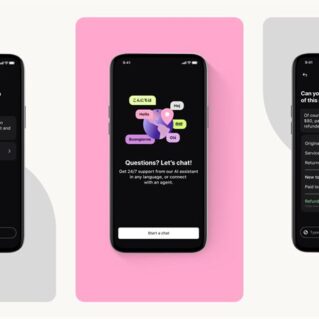According to a recent article by Forbes, technology to compete against a disruptive Amazon will continue to be central to the retail play of 2019.
However, it isn’t the only thing driving what will makes retailers’ tech shopping list. While you can expect to see more holographic 3D images at malls and stores to wow you, the following six trends from last week’s National Retail Federation’s annual “Retail’s Big Show” will have a more lasting impact.
More cloud-connected machines, part of the IoT (Internet of things) buzz, are coming to stores.
As Starbucks baristas gave out free samples at a makeshift coffee station inside a Microsoft booth, screens behind them displayed data like how many cups the machines had brewed. This arrangement was no coincidence: Starbucks has teamed up with Microsoft to connect its coffee and other machines to the cloud via Microsoft’s Azure Sphere IoT system.
Why is this initiative relevant? When Starbucks introduces a drink recipe, it would now be able to remotely update all its connected devices, a faster alternative to manually delivering a USB drive that’s inserted into the machine hardware before a barista can make that new espresso drink, for instance, a Microsoft spokesperson said at the booth. Starbucks also can instantly track and aggregate sales and other data and see what’s popular with consumers when and where.
Starbucks said the move also will give its employees more opportunity to engage with customers and can help with “beverage consistency, waste reduction, the management of energy consumption and predictive maintenance.”
While Starbucks has been late and didn’t start its “migration to the cloud” until about three years ago, it has been working with its Seattle neighbor closely to help with the transition.
Yes, Amazon Go is about to change the way we shop.
Amazon Go has received generally very positive consumer feedback, forcing the rest of the industry to play catch up. At the Intel booth, for instance, a cashierless store concept and a smart vending machine the chip giant developed with China’s e-commerce retailer JD.com for that market were showcased. A JD.com spokesperson said the company traveled to the show with the intention to explore licensing its cashierless technology to U.S. and other retailers.
Expect to see more retailers seeking to come up with their own Amazon Go-like cashierless experience for you.
More robots will become fulfillment centers’ model employees.
With Amazon’s 100,000-plus robotic drive units a big part of its fulfillment-center secret sauce, rivals are eager to employ their own robots to help fulfill growing online orders faster.
Tompkins Robotics, for example, has introduced its own t-Sort robotic drive units that can sort individual items to help retailers cut the order processing time. Four of the top 15 U.S. retailers are its customers, Tompkins Robotics President Mike Futch said, declining also to specify.
To be sure, Tompkins’ robotic unit is different from Amazon’s, which has the ability to move and navigate an entire shelf of a mix-match of products.
On shopping floors, drones join robots as new store employees.
2019 will continue to be the year when retailers seek to use technology to free store employees from menial tasks so they can spend time instead servicing customers. Retailers also want to use tech to help track what’s missing and misplaced on shelves and better keep inventory in stock. At the Intel booth for instance, Pensa Systems showcased drones that track store-shelf inventory for customers including beverage giant AB InBev.
Meanwhile at Giant Food Stores, the supermarket chain this year will deploy a “googly-eyed” robot, which it named Marty, to all of its 172 stores after a successful pilot that had Marty inspect its floors to make sure there are no “hazards” like spills.
With increased online spending, delivering on experience when shoppers actually visit a brick-and-mortar store is more crucial than ever.
Making the cost of returns less painful to stomach.
With increased global online sales also come increased returns, and retailers are seeking help to handle that process.
For instance, four-year-old ZigZag, which counts Topshop and Gap customers, has built a network of 200 warehouses in 130 countries to handle cross-border returns. That includes helping retailers grade the returned item’s quality, retag, relocate, bulk ship and resell products.
What’s at stake isn’t just the cost and time returns take. For the fashion industry, the ability to turn around a return and resell it while in season could reduce the steep clearance risk later. And with more brands selling internationally, there’s the opportunity to sell a returned Topshop swimsuit in the winter in Europe by bulk shipping it with other items for sale to Topshop customers in Australia, for instance.
B-Stock, a liquidation marketplace platform for retailers including Amazon and, said in December that one out of every three people would return a holiday gift, translating to what it estimated would be $90-$95 billion worth of returns post-holiday.
Your local store shelves are getting digital, and it’s not just about cutting paper tag costs.
While more retailers are looking to turning their shelves digital to save the time and paper tag costs on traditional price promotions updates, Kroger is working with Microsoft to give its digital shelves more bells and whistles. At two Kroger test stores, the shelves will connect with Kroger’s scan-and-go shopping app to guide customers through their shopping list. They can also flash lights to give employees visual cues to help them pick and fulfill curbside delivery orders quickly. Kroger also plans to turn its shelves into digital advertising space for CPG brands.
Kroger, through its own Sunrise Technology unit, has said it also is seeking to license its in-house built digital shelf and other technologies to even fellow rival retailers.
With Amazon—and fickle consumers—keeping retailers on their toes, thinking outside of the box for new growth opportunity will be the new industry norm.


